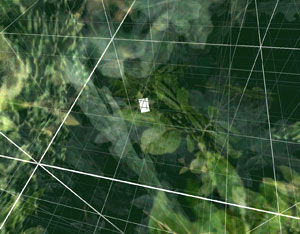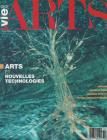lt is something we never know in the present moment, if reality is a dream or if the dream is reality.Milan Kundera [1]
Does high-end technology today carry the possibility of reconciling with nature? After having allowed us to satisfy our will for power and to take distance from our environment, which sometimes turns out to be dramatic, will our tools help us to go back in the course of time, to that mythical period in which human and nature were one? Challenging the almost palpable pessimism of our time is the premise of Osmose [2], an immersive virtual space created by the artist Char Davies, thanks to the software of Softimage, a young Quebec company that imposed itself worldwide in the beginning of the 9O's in the field of three-dimentional computer animation.
We have to admit, Osmose is provided with astonishing and unprecedented characteristics, which set it apart from the technically advanced, but until now aesthetically very conventional, so called «virtual reality». In most examples, a helmet with stereoscopic visual display diffuses sounds but mostly images, passing so close to the eye that it almost invades the whole field of view, creating the illusion of being «inside» the images. In other respects, the computer iswconventionally linked to a glove provided with sensors that constantly «reconfigure» the content of the field of view according to the movements of the hand. The result of this is are new illusions, the one of moving to the left, to the right, forward, backward, up or down. Rise, jump, fly, all this becomes possible, without effort, because the gravitational forces are disabled: with the crisp sensation of being carried away, literally in another world.
A virtual reality apart.
Osmose breaks new grounds in at least three essential aspects: by the «navigation», the quality of the images and goal proposed. Instead of a glove, we slip into an adjustable vest that interprets left-right, forward-backward movements as well as movements of breathing. So, we rise when we inhale and we go down when we exhale. The body is brought into play by its movements and with one of its essential organic functions. Then the images and their objects . . . With few exceptions, the vast majority of actual virtual reality pieces remain without surprises regarding graphics - i.e. sharp lines, hard edges, saturated colours - and imagination bumps into rigid and closed parameters. These worlds of fiction have, besides, defined aims, more or less copied from the military model: in general the goal is to eliminate, to erase an entity or opponent. In this regard, they play the part, - and couldn't do it any better - of the manipulative westem worldview, tuned toward a single goal: control as pure spirit, perfectly dísembodied, a world where surprise, doubt and ambíguity, and therefore mystery, have been erased.
With Osmose, slight movements of the torso and controlled breathing allow us to manoeuver from «world-space» to «world-space»: the «forest», the «clearing», the «leaf», the «ground», the «pond», the «abyss» and the «sky» overlap and follow one another according to our change of location. The colours, mainly in natural tones of brown, green and sepia, hardly distinct, with imperceptible gradations. Some «landscapes» are covered with sparkling lumínous particles, veritable constellations creating fugitive impressions of movement and depth. Like the paintings Davies did in her previous life, the images deliberately sway between figuration and abstraction. For example, the leaves are clearly recognizable, but because of their soft and moving style, we cannot at anytime confuse them with reality like a film or a video. We find ourself physically immersed in the «idea» of a leaf, in pure representation. Finally, the complex and undefined «textures», especially in the zones between two world-spaces, increase the impression of finding ourself in an oniric and ambigous space: a world almost organic, almost synthetic, almost mineral, almost figurative, almost . . . real, where you can nearly move at will.
An interior world which is not ours to control
Because we cannot do whatever we want to in Osmose . . . Trying to grab an image, to fix a plane, to go towards a specific point (as when we want to distinguish the pigment or the texture of a painting) exposes one to frustration, frustration that is quickly dispersed however by the curiosity aroused by unusual activity in one corner, the emergence of a plane or a depth, the sudden dive into a new «wor1d». This virtual space opposes our fantasies and, onto our will exerts a subtle but nevertheless tangible resistance. We exert some power, but are however limited by forces that defy us to a large extent, a little like humans hundreds or thousands of years ago. Our senses use a seductive language that we know to be untrue. Finally our Spectator status cannot be more uncertain and complex because we are at the same time transmitter and receptor, host and guest of this complex apparatus, where we create a unprecedented succession of images. This installation, within which we are the space, evolves in us, litteraly . . .

Osmose
Interactive, immersive virtual space, presented at the Museum of Contemporary Art in Montreal from August 19th to October 1st, 1995
All this gives rise to the diffuse feeling, manifesting itself between Osmose and us, or we might as well say between mind and body, of sensing the buoy becoming blurred, of slipping the mooring ropes, of not being anchored to reality: the usual references are not simply abolished, that would be too simple, but subtlely altered, shifted [3]. The interior computer, used for decades to sort and process physical and organic data solid and real - on the opposite of aesthetic (given information or data), which it has quickly understand that they were often deliberately distorted or ambiguous, finds itself short-circuited, in constant shift.
The Osmose Effect
Primitive astonishment.
Cautious amazement.
Sensation of floating in a wonder world, abandoned to the caprices of random forces whereby origins and logic escapes us - but where anything is possible. To get one's bearings, each person has no other choice but to retum into oneself, to concentrate on the origin of his or her movements, in this state of osmosis between the body and this exterior/interior. Without really noticing, he or she lingers on her or his subtle movements, as psychologists say, and on her or his breathing. A place of exchange between inside and outside, in organic time from where rhythm, frantic or quiet, reverberates in the whole body, this fundamental organic phenomenon is a familiar daily miracle. Universal and constant voluntary/involuntary activity, in which stopping means death, breathing animates numerous esoteric and spiritual traditions, especially through meditation.
Here is explained Davies' ambition to reopen the awareness dimension, the communication with the world, the same one who closed itself as much on nature as on ourselves (dés lors that our knowledge and our tools allowed us to explain and dominate the most part of the visible. Osmose discourages agressive behavior (excesive speed causes us to we find ourselves in a very Cartesian grid, less rich visually) in favor of a gentler approach, more sensitive and intuitive. In favour of a listening attitude, which would inspire us and would inscribe itself in our limbs and our interior fibre, as in an earlier time where nature enveloped us completely and required from us a constant awareness of our inside and outside worlds, an awareness that we foolishly exchanged for the sleep of the civilized.
Will Osmose be able to achieve this, to enchant the world for us again, as Davies would like? Will she succeed in giving it back - and if so, to how many of us? [4] - this part of the mystery and unknown which will, at last urge us to stop, our senses on the watch, trying to distinguish what is moving there, in the foliage? Everything is possible, as soonas she incites us to tame again the idea that the world, despite our fabulous tools, remains a place that deserves to be explored carefully, would it only be because we have a chance to discover the most peculiar animal, the most fabulous - and sometimes the most worrying of all creation: ourselves.
Notes
[1] La vie est ailleurs, Gallimard collection Folio, 1982, p. 251[2] Shown at the 6th International Symposiom on Electronic arts (ISEA 95), Osmose is a work in progress, destined to be enriched with new elements in the course of the next months.
[3] The comment on such a virtual space can only be subjective, and this descriptive picture points back to a stubborn ídealism from the commentator and of the conditions of experimentation: to the rariety of esthetic references is added the particularity of the point of view: here it's impossible to go back, to turn around the work as it would be feasible with a painting or a sculpture: we are «inside» or we are not - moreover it is inside us or it is not.
[4] At a rate of 4 persons per hour, the capacity of Osmose is certainly limited. But in the installation at the Museum, spectators can, with the help of stereoscopic glasses, follow on a large video screen the images seen in real time by the person in the helmet whose shadow-silhouette is projected on a translucent screen.
This article may include minor changes from the original publication in order to improve legibility and layout consistency within the Immersence Website. † Significant changes from the original text have been indicated in red square brackets.
